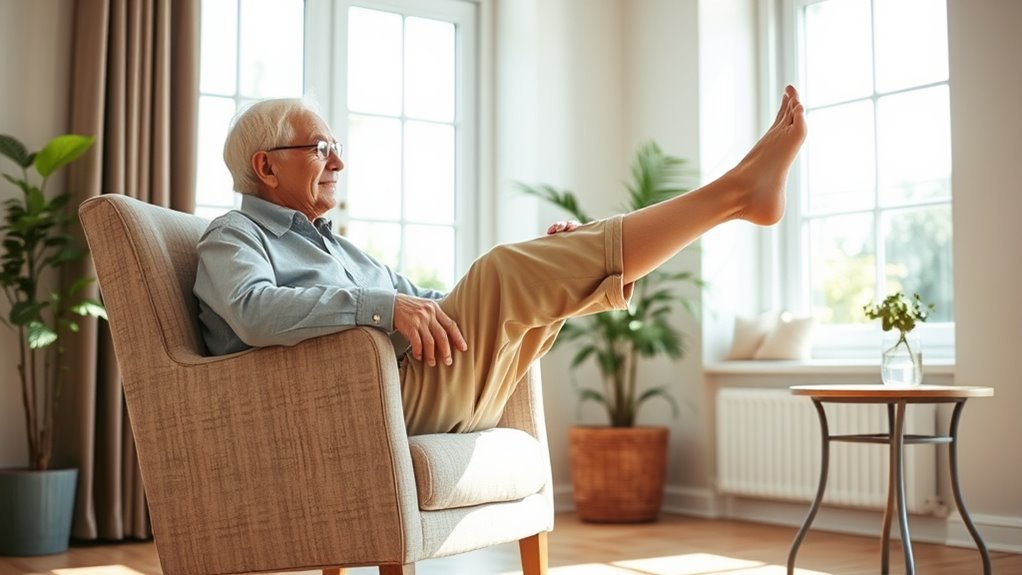You can prevent falls by doing simple exercises right in your chair. Focus on lower body moves like seated marching, sit-to-stand, leg extensions, and knee lifts to build strength and improve balance. Add ankle circles and spinal rotations to enhance stability and mobility. Incorporate upper body stretches and arm raises for posture and confidence. Keep moving slowly and with control. Stick with these routines regularly, and you’ll discover more tips to stay steady and safe.
Key Takeaways
- Incorporate seated leg lifts, knee lifts, and sit-to-stand exercises to strengthen lower body muscles and improve balance.
- Perform ankle circles and spinal rotations to enhance joint mobility and stability, reducing fall risk.
- Use arm raises and core twists to activate upper body strength and promote better posture.
- Practice seated side bends and controlled stretches to improve flexibility and alignment.
- Always sit upright with feet flat, move slowly, and engage core muscles during exercises for safety.
Seated Marching for Lower Body Strength
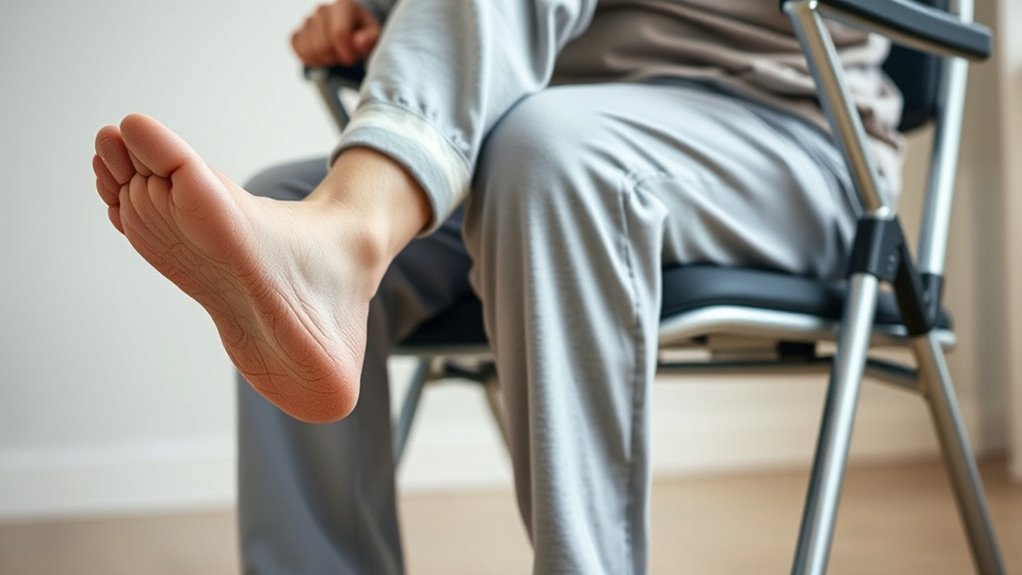
Seated Marching is an effective exercise to strengthen your lower body and improve balance. To get the most out of this exercise, focus on your chair cushion selection and guarantee your seat provides ergonomic seating. A supportive, well-cushioned chair helps maintain proper posture, reducing strain on your hips and back. Sit upright with your feet flat on the ground, and engage your core. Lift one knee toward your chest, then lower it back down, and repeat with the other leg. Keep your movements controlled and steady. Using a comfortable, ergonomic chair encourages better form and stability, making the exercise safer and more effective. Proper body alignment is essential for preventing strain and maximizing benefits. Consistent practice can enhance muscle strength, boost your confidence, and help prevent falls.
Chair Sit-to-Stand Exercises

Chair sit-to-stand exercises are a practical way to improve your lower body strength and enhance your balance. By regularly practicing chair sit-to-stand exercises, you build muscle in your legs and hips, which are essential for fall prevention strategies. To start, sit upright in a sturdy chair with your feet flat on the ground. Stand up slowly, using your leg muscles, then sit back down gently. Focus on controlled movements without rushing. Repeat this motion 10 to 15 times, gradually increasing as you gain strength. Incorporate these exercises into your daily routine to help stabilize your movements and reduce fall risk. Consistent practice can boost your confidence and independence, making everyday tasks safer and easier.
Ankle Circles to Improve Stability

To improve your stability and reduce the risk of falls, ankle circles are an effective exercise you can do anywhere. Sit comfortably with your feet flat on the floor. Lift one foot slightly off the ground and rotate your ankle slowly in a circular motion. Complete 10 circles clockwise, then 10 counterclockwise, and switch to the other foot. This movement helps strengthen your ankles by promoting ankle strengthening and enhances joint lubrication, which keeps your joints moving smoothly. Regularly practicing ankle circles increases your balance and stability, making it easier to recover from missteps. Keep the movements controlled and gentle, avoiding any pain. Incorporating this simple exercise into your routine supports stronger ankles and improved overall fall prevention. Using vetted home exercise equipment can further enhance your balance training.
Leg Extensions to Enhance Balance
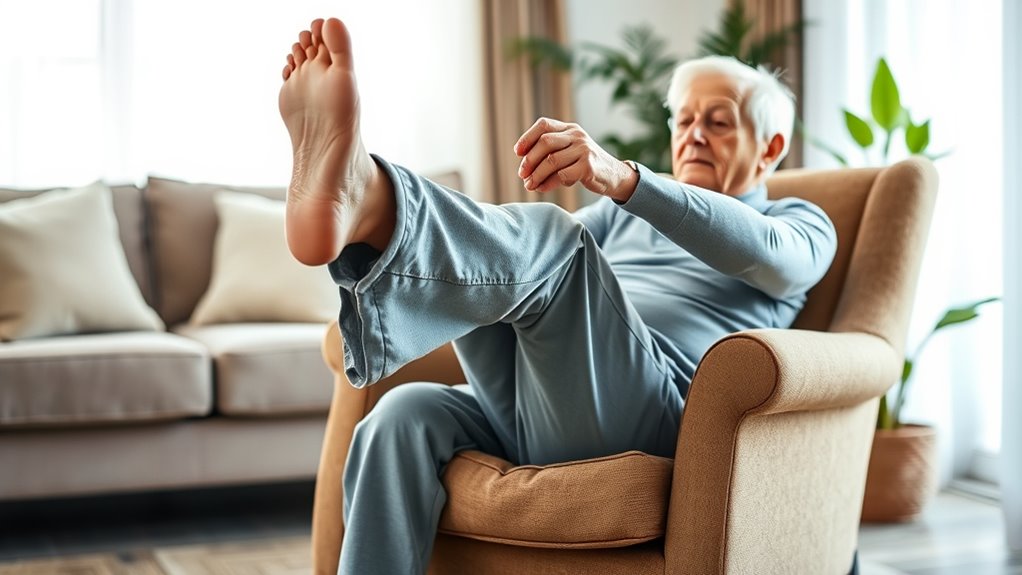
To get the most benefit from leg extensions, focus on proper form by keeping your back straight and avoiding rapid movements. This exercise helps improve stability by strengthening your quadriceps and enhancing your balance. When done correctly, leg extensions can be a simple yet effective way to reduce fall risk. Incorporating muscle strengthening through targeted exercises like leg extensions can further support your overall stability and safety.
Proper Technique Tips
When performing leg extensions to improve balance, maintaining proper technique is vital to prevent injury and maximize benefits. Sit upright with your back straight and feet flat on the floor. Engage your core and avoid slouching, similar to the mindful posture promoted in chair yoga. As you extend one leg, keep your foot flexed and move slowly to avoid jerking. Use ergonomic tips, like adjusting your chair height so your knees are level or slightly below your hips, to guarantee proper alignment. Keep your movements controlled and avoid locking your knee at full extension to prevent strain. Focus on smooth, deliberate motions, and breathe steadily. Consistently practicing proper form helps build strength and stability safely. Additionally, being aware of your AI safety practices can help you stay informed about technological developments that may impact health and safety standards.
Benefits for Stability
Leg extensions are an effective way to boost your stability by strengthening the muscles responsible for maintaining balance. By practicing these exercises regularly, you enhance your balance training, which directly reduces your fall risk. Strong quadriceps help you stabilize your legs during everyday movements, making it easier to recover from slips or shifts. Improved muscle strength from leg extensions also supports better posture and coordination, both essential for fall prevention. Incorporating these exercises into your routine helps you build a solid foundation of stability, especially important if you’re at higher risk of falling. Consistent practice can lead to enhanced confidence in your movements and a decreased likelihood of accidents, empowering you to stay active and safe in your daily life. Additionally, targeted strengthening of leg muscles can improve your muscle balance, contributing further to your overall stability and safety.
Seated Torso Twists for Core Activation

Seated torso twists are an effective way to activate your core muscles and improve rotational stability, which can help prevent falls. Sit upright on a chair with a firm chair cushion for support. Place your feet flat on the ground and position your arms comfortably on the armrests or crossed over your chest. Keep your back straight and engage your core as you gently twist your torso to one side, then return to center before twisting to the other side. Focus on controlled movements and avoid over-rotation. Adjust armrest positioning if needed to ensure comfort and stability. To maximize benefits:
- Keep your hips facing forward during twists
- Maintain a slow, controlled pace
- Breathe steadily throughout the exercise
- Use your chair cushion for added support
- Incorporate best anime movies into your relaxation routine for mental well-being.
Heel and Toe Raises for Foot and Ankle Strength
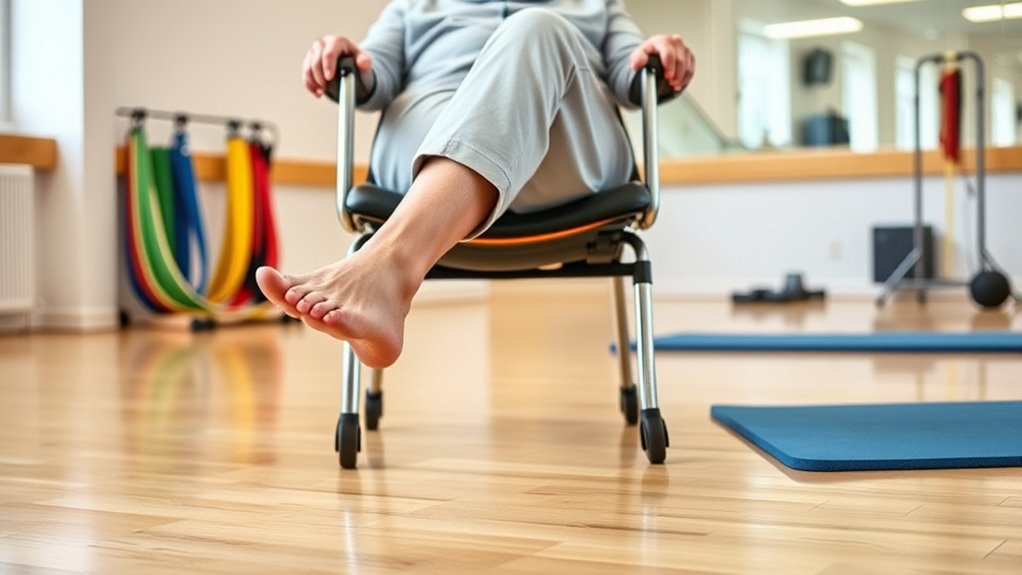
Heel and toe raises are simple yet effective exercises to strengthen your foot and ankle muscles, which play a vital role in maintaining balance and preventing falls. By doing these movements regularly, you improve ankle flexibility and boost foot mobility, making it easier to respond to uneven surfaces or sudden shifts in balance. To perform heel raises, lift your heels off the ground while keeping your toes planted, then lower back down slowly. For toe raises, lift your toes while keeping your heels on the floor, then lower. These exercises target key muscles that support your ankles and feet, helping you develop better stability. Incorporating heel and toe raises into your routine can substantially enhance your overall balance and reduce fall risk.
Seated Side Bends to Increase Flexibility

When performing seated side bends, maintaining proper posture alignment helps prevent strain and guarantees effectiveness. Use controlled bending techniques to target your muscles safely, avoiding sudden movements. Remember to breathe steadily; deep breaths can enhance your flexibility and support your overall balance. Incorporating mindful awareness during your exercises can also improve mindfulness practices, leading to better focus and relaxation.
Proper Posture Alignment
To improve your posture alignment and enhance flexibility, incorporating seated side bends into your routine can be highly effective. These movements support posture correction by gently stretching your sides and back, helping to improve alignment. Proper posture correction reduces strain on your spine and muscles, promoting better balance and stability. To maximize benefits, focus on controlled, smooth movements that target the sides of your torso. Additionally, paying attention to creating an interior design mood board can inspire a calming environment that encourages mindful movement and relaxation during your exercises.
- Sit upright with feet flat on the floor, shoulders relaxed
- Reach one arm overhead, gently bending to the opposite side
- Keep your hips stable and avoid twisting your torso
- Hold the stretch for a few seconds, then switch sides
Regular practice of seated side bends can contribute notably to alignment improvement, helping you stand and sit with better posture daily.
Controlled Bending Technique
Practicing controlled bending during seated side bends guarantees you effectively stretch your sides while maintaining proper form. Focus on balance awareness to stay steady and prevent overextending. As you bend sideways, keep your movement slow and deliberate, ensuring muscle relaxation in your torso and shoulders. Engage your core to support your spine and avoid strain. By moving with control, you increase flexibility safely and reduce the risk of imbalance or injury. Remember, gentle, consistent stretches are key to improving your range of motion without overexertion. Pay attention to how your muscles feel, relaxing any tension as you stretch. This mindful approach helps you build flexibility gradually while maintaining stability, making your seated exercise both effective and safe. Being aware of your body’s signals during stretching can further prevent overstretching and injury.
Breathing for Flexibility
Focusing on your breathing during seated side bends enhances flexibility and helps you move with greater ease. Proper breathing techniques amplify the benefits of flexibility exercises by relaxing your muscles and increasing oxygen flow. As you inhale, prepare to stretch; as you exhale, deepen the bend gently. This mindful breathing encourages better muscle elongation and reduces tension. To maximize the exercise, try these tips:
- Inhale deeply before initiating the side bend
- Exhale slowly as you stretch further
- Maintain steady, even breaths throughout
- Use your breath to guide your movement smoothly
Incorporating breathing techniques into your flexibility exercises helps you stay relaxed and improves your overall mobility, reducing fall risk and promoting better posture. Breathing techniques also support overall safety during physical activity by helping you stay calm and focused.
Arm Raises to Promote Overall Stability
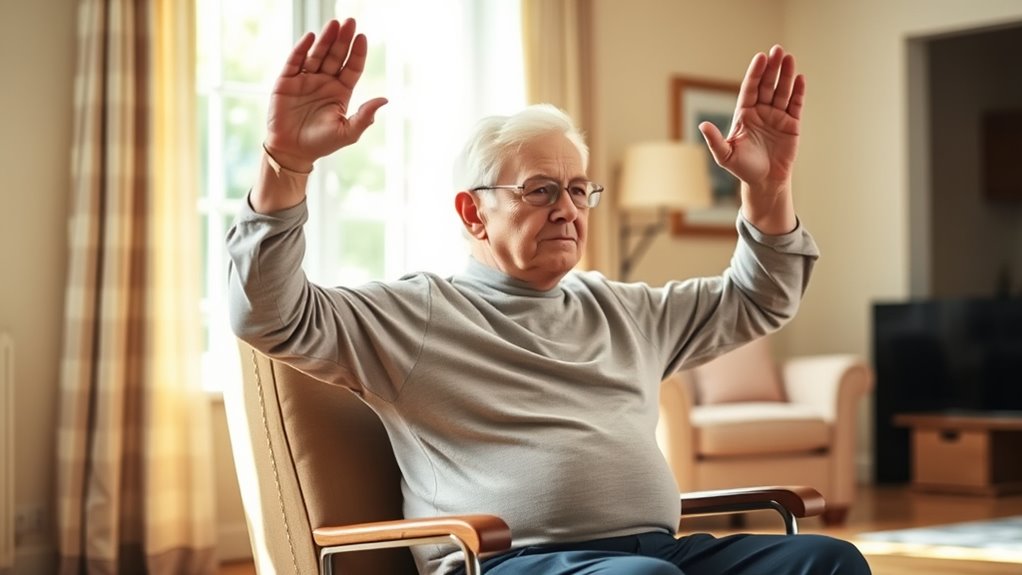
Arm raises are a simple yet effective way to enhance your overall stability. By focusing on your arm strength, you improve your upper body stability, which is essential for maintaining balance. To do this exercise, sit tall in your chair with your feet flat on the floor. Raise your arms out to the sides or overhead, keeping them straight and controlled. Hold for a moment, then slowly lower them back down. Repeat this movement for several repetitions. This exercise helps strengthen the muscles around your shoulders and upper back, providing better support for your posture and balance. Consistently practicing arm raises can help you feel steadier on your feet and reduce your risk of falls. It’s a simple addition to your fall prevention routine.
Seated Knee Lifts for Balance and Coordination
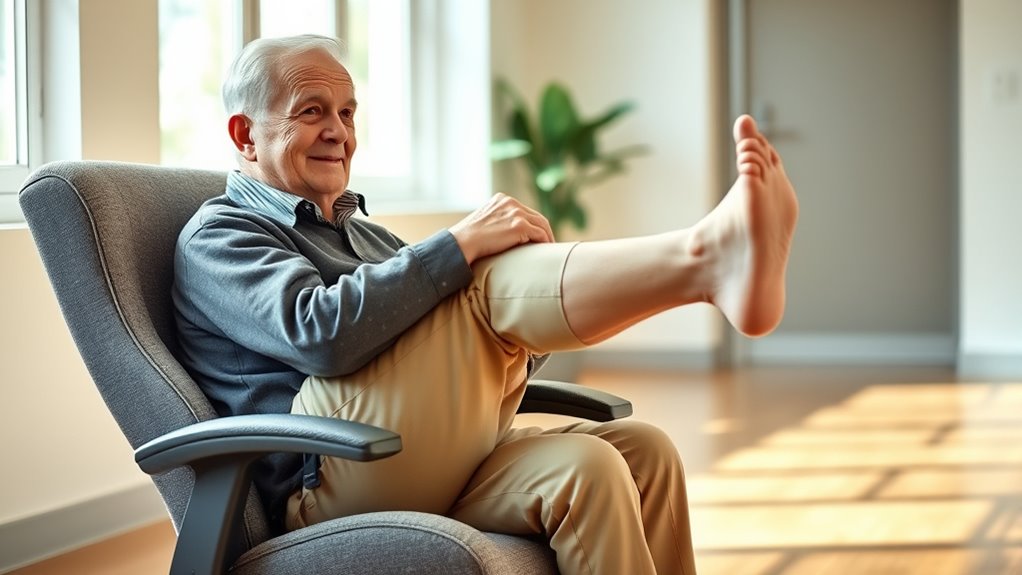
Building on your improved upper body stability, strengthening your lower body also plays a key role in maintaining balance. Seated knee lifts are effective for enhancing coordination and promoting hip flexibility, which supports better movement. As you lift each knee, you encourage joint lubrication, reducing stiffness and increasing mobility. Consistent practice can improve your stability, helping prevent falls.
- Sit upright with feet flat on the floor
- Alternately lift each knee toward your chest
- Keep your core engaged for better balance
- Breathe steadily throughout the exercise
This simple movement not only boosts joint health but also strengthens your leg muscles, making everyday activities safer. Incorporate knee lifts regularly to help maintain your independence and reduce fall risks.
Gentle Seated Spinal Rotations

To get the most out of gentle seated spinal rotations, it’s important to use proper technique to avoid strain. Focus on slow, controlled movements that turn your upper body without forcing the neck or lower back. These rotations improve spinal mobility, helping you move more freely and maintain better balance.
Proper Rotation Technique
Gentle seated spinal rotations are an effective way to improve flexibility and balance, especially for those at risk of falls. To practice proper rotation technique, focus on maintaining rotation safety and torque control. Start by sitting tall with your feet flat and shoulders relaxed. As you gently turn your torso to one side, keep your hips stable and avoid over-rotating to prevent strain. Breathe steadily throughout the movement, and avoid any jerky motions. Remember, controlled movements help prevent injury and maximize benefits.
- Keep your back straight and avoid slouching
- Use your core muscles to initiate the rotation
- Move slowly, emphasizing control over speed
- Stop immediately if you feel discomfort or pain
Benefits of Spinal Mobility
Engaging in seated spinal rotations can considerably enhance your flexibility and balance, which are crucial for fall prevention. These gentle movements improve spinal flexibility, allowing your spine to move more freely and reducing stiffness. Better nerve health results from maintaining mobility, as it promotes ideal nerve signaling and reduces compression. Incorporating spinal rotations helps keep your nervous system responsive and resilient. Here’s a quick look at their benefits:
| Benefit | Explanation |
|---|---|
| Increased Flexibility | Enhances range of motion in your spine |
| Improved Balance | Supports stability during daily activities |
| Nerve Health | Maintains nerve function and reduces discomfort |
| Fall Prevention | Boosts confidence and mobility for safer movement |
Frequently Asked Questions
Are Chair Exercises Suitable for All Age Groups?
You might wonder if chair exercises suit every age group. The good news is, with age-specific modifications, these exercises benefit all ages by improving strength, flexibility, and balance. Younger individuals can use them for gentle warm-ups, while seniors gain stability and confidence. Always tailor chair exercise benefits to your needs, ensuring safety and effectiveness. So, yes, chair exercises are versatile and adaptable for everyone, regardless of age.
How Often Should I Perform These Chair Exercises?
Did you know that exercising just three times a week can markedly improve your balance? For your exercise frequency, aiming for daily routine is ideal, especially if you’re focusing on fall prevention. Consistency matters, so try to incorporate these chair exercises into your schedule regularly. Even short daily sessions help strengthen muscles and improve stability, reducing your fall risk over time. Stay committed, and you’ll notice the benefits faster.
Can These Exercises Prevent Falls in Individuals With Osteoporosis?
You ask if these exercises can prevent falls in people with osteoporosis. While they may not eliminate osteoporosis risk, regular activity improves strength and balance, making falls less likely. Exercise effectiveness varies, but combining chair exercises with other osteoporosis treatments can help. It is crucial to consult your healthcare provider to develop a safe plan tailored to your needs, maximizing benefits and reducing fall risk effectively.
Are There Any Safety Precautions I Should Follow During Chair Exercises?
Safety should be your top priority during chair exercises. Start with guaranteeing your chair has stable, sturdy support to prevent falls. Focus on maintaining good posture and avoid overexertion. Use exercise modifications if needed—like reducing range of motion or seated support—to suit your comfort level. Always listen to your body and stop if you feel dizzy or unsteady. Staying safe ensures you can confidently continue your fall prevention journey.
Can Chair Exercises Replace Outdoor Balance Training?
While chair exercises are great for building strength and stability, they can’t fully replace outdoor balance training. Outdoor activities provide dynamic challenges and fresh air, enhancing your overall balance and coordination. Using exercise equipment outdoors can boost your progress, but you still need real-world practice. To stay safe, combine both indoor chair routines and outdoor balance exercises, ensuring you develop holistic stability while enjoying the benefits of nature.
Conclusion
Incorporating these chair exercises can markedly boost your balance and strength, reducing fall risk. Did you know that falls are the leading cause of injury among older adults, but regular activity can decrease this risk by up to 40%? So, make these simple moves part of your routine. Staying active keeps you safer and more confident every day. Just a few minutes can make a big difference in maintaining your independence!
